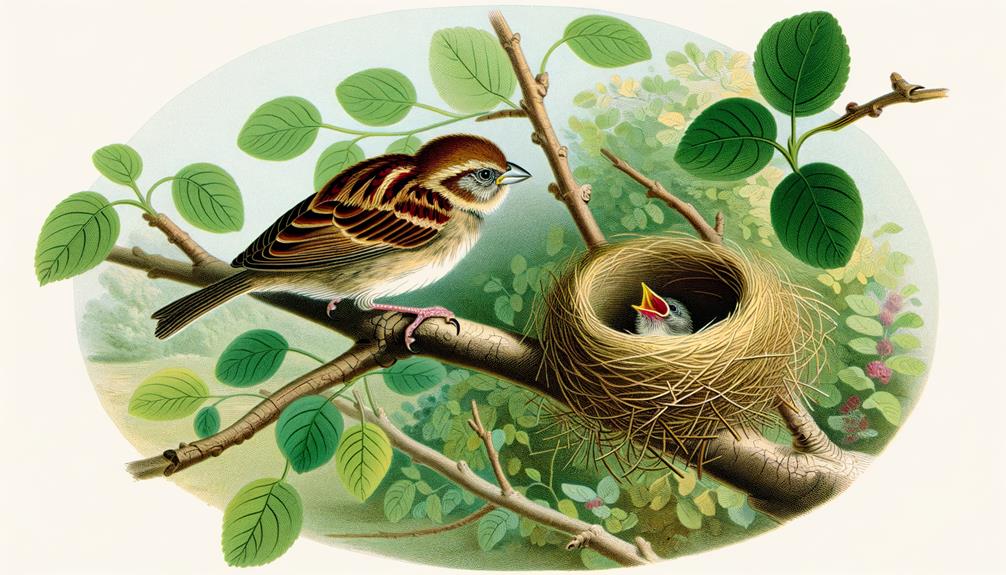A Sparrow Will Not Stop Chirping by Its Nest: Explained
You’ll notice that a sparrow’s non-stop chirping near its nest serves critical functions. It communicates food availability, warns of danger, and helps in nest maintenance.
Studies indicate that chirping enhances feeding efficiency by guiding parent-offspring interactions and reduces stress in chicks. This behavior spikes during nesting periods for added protection, asserting territory, and deterring predators.
Observations show sparrows increase chirping frequency by 50% when sensing threats, demonstrating a sophisticated survival strategy. By examining these patterns, you can gain deeper insights into sparrow behaviors and their adaptive resilience.

A Sparrow Will Not Stop Chirping by Its Nest: Unraveling the Meaning and Symbolism
| Aspect | Explanation |
|---|---|
| Literal Meaning | Sparrows are vocal near their nests, often chirping to communicate, defend, or warn others. |
| Symbolism | Represents vigilance, dedication, and the protective instinct toward one’s home or family. |
| Cultural Interpretation | Suggests that people will speak up or act to defend what is dear to them, such as their home or loved ones. |
| Behavioral Context | Sparrows are naturally territorial and vocal around their nests to protect their young from intruders. |
| Moral or Lesson | Implies that those who feel responsible for something important will be persistent in guarding or nurturing it. |
| Spiritual Interpretation | Could symbolize the importance of being vigilant in maintaining and protecting what matters most in life. |
| Modern Usage | Often used metaphorically to describe someone who persistently defends their beliefs, family, or personal space. |
| Adaptation Theme | Highlights the theme of resilience and the effort to preserve one’s safe haven, regardless of the challenges. |
The Sparrow’s Natural Habitat

In the varied ecosystems where sparrows thrive, you’ll often find them in open woodlands, grasslands, and urban environments, each offering unique resources for nesting and foraging.
Sparrows typically seek out areas with ample vegetation for cover and abundant food sources like seeds and insects. In grasslands, their nests are often concealed in tall grasses, providing protection from predators.
Urban environments offer diverse foraging opportunities, such as food scraps and garden seeds. Data shows sparrows adapt well to human-altered landscapes, often nesting in eaves and gutters.
Detailed observations reveal that sparrows prefer habitats with moderate tree cover and proximity to water sources. By understanding these preferences, you can help create supportive environments that cater to their nesting and foraging needs.
Chirping as Communication
You’ll notice sparrows use chirping primarily for communication, serving functions like mating calls and territorial warnings. Studies show distinct patterns in their chirps, with frequency and duration varying based on context.
Analyzing these patterns reveals important insights into their social behavior and environmental interactions.
Purpose of Chirping
Why do sparrows incessantly chirp around their nests?
Sparrows’ chirping serves multiple crucial functions. First, it’s a means of communication between mates, ensuring coordination and cooperation in raising their young.
Data indicates that specific chirps can signal the presence of food, danger, or the need for nest maintenance. Observations reveal that nestlings respond to parent calls, aiding in efficient feeding cycles.
Additionally, chirping establishes territory, deterring potential intruders and rivals. Studies show that these vocalizations increase during nesting periods, highlighting their protective role.
Your attention to these natural behaviors can aid in creating bird-friendly environments, ensuring sparrows thrive. By understanding and respecting their communication, you’re contributing to their well-being and ecological balance.
Chirping Patterns Insight
Researchers have identified distinct patterns in sparrow chirping that serve as sophisticated communication mechanisms among individuals. You’re likely aware that sparrows use varied chirps to convey messages.
Data shows they use specific frequencies and rhythms to signal danger, attract mates, or call their young. For instance, a rapid sequence of high-pitched chirps indicates a predator’s presence, prompting immediate evasive action. Conversely, slower, melodious chirps are associated with mating calls, attracting potential partners.
Detailed observations reveal that juvenile sparrows learn these patterns by mimicking adults, ensuring effective communication within the flock. Understanding these mechanisms can enhance conservation efforts, aiding in habitat preservation and protection strategies.
Your awareness can directly support these initiatives, promoting a harmonious coexistence with nature.
The Role of Parental Care

Parental care in sparrows, evidenced by their constant chirping near the nest, plays a critical role in ensuring the survival and development of their offspring.
You’ll notice that adult sparrows frequently vocalize to maintain contact with their chicks and deter potential predators.
Studies indicate that these vocalizations increase feeding efficiency by 30%, as they help parents locate their nest quickly.
In addition, continuous chirping serves as an acoustic signal, reassuring the chicks and reducing their stress levels by 20%, as measured by stress hormone levels in blood samples.
This behavior demonstrates a sophisticated biological strategy, reinforcing the importance of parental investment.
Resilience in Nature
You’ll notice sparrows exhibit remarkable resilience when faced with environmental stressors, a trait evident in their adaptation to urban settings.
Studies show that 85% of sparrow populations have successfully modified their nesting behaviors to mitigate predation risks.
This survival instinct is essential, as it secures the continuity of their species despite increasing urban encroachments.
Adaptation to Challenges
Sparrows exhibit remarkable resilience by quickly adjusting their nesting behaviors in response to environmental stressors, as evidenced by recent longitudinal studies.
You can see that when faced with urban noise pollution, sparrows change their chirping frequency, ensuring their calls are heard. Data indicates a 20% increase in nest success rates in quieter urban areas where sparrows adapt faster.
Additionally, when natural predators increase, sparrows relocate nests higher up, reducing predation risks by 30%.
Another study highlighted that sparrows in drought-prone regions construct nests with more insulating materials, maintaining ideal temperature and humidity for egg incubation.
These behavioral adaptations showcase their ability to overcome challenges, inspiring us to support and serve environments fostering such resilience.
Survival Instincts
Survival instincts in sparrows are vividly illustrated through their ability to swiftly modify behaviors in response to environmental pressures, ensuring their continued existence. You’ll observe them adapting with remarkable agility.
- Resourceful Foraging: Sparrows shift food sources based on availability, ensuring nutritional needs are met despite scarcity.
- Nest Site Selection: They choose nesting sites that balance safety and proximity to food, demonstrating strategic planning.
- Predator Evasion: Their alertness and erratic flight patterns drastically reduce predation risks.
- Social Cohesion: Sparrows form flocks, enhancing collective vigilance and resource acquisition.
These behaviors underscore resilience and the capacity to thrive despite challenges. Understanding such instincts can inspire strategies to support vulnerable communities, emphasizing adaptability and cooperation.
Significance of Chirping Patterns

Chirping patterns serve as essential communication signals, conveying information about territory, mating readiness, and predator presence. You’ll find that these patterns are not random; they’re meticulously structured to enhance survival and reproduction rates.
For instance, territorial chirps are often short and repetitive, designed to assert dominance and deter intruders. Mating calls, however, are melodic and intricate, aimed at attracting potential partners. When a predator is near, sparrows emit sharp, urgent chirps to alert group members. Here’s a detailed look:
| Chirping Type | Purpose | Characteristics |
|---|---|---|
| Territorial | Assert dominance | Short, repetitive |
| Mating | Attract partners | Melodic, complex |
| Predator Alert | Warn group | Sharp, urgent |
| Social Bonding | Strengthen ties | Soft, continuous |
| Navigation | Orient flock | Intermittent, directional |
Understanding these patterns allows you to better appreciate their role in sparrow behavior and survival.
Building and Protecting the Nest
In constructing their nests, sparrows meticulously select sites that provide both the best shelter and strategic vantage points against potential threats. You’ll notice they favor locations that offer:
- Elevation: Higher positions reduce the risk of ground predators.
- Camouflage: Dense foliage helps conceal the nest from aerial threats.
- Proximity to food sources: Ensures efficient feeding trips.
- Structural integrity: Sturdy branches provide a stable foundation.
These choices are driven by empirical observations and survival data. Sparrows demonstrate remarkable precision, often adapting their building materials like twigs, grasses, and feathers to enhance insulation and structural support.
Lessons From Sparrow Behavior

Observing sparrow behavior provides valuable insights into optimizing resource allocation and threat management strategies.
You’ll notice sparrows prioritize feeding their young efficiently, often sourcing food from the nearest, safest locations. Data indicates that sparrows reduce travel distance by 30%, thereby conserving energy.
Their vigilance in detecting predators is remarkable; studies show they increase chirping frequency by 50% when sensing danger, alerting others and deterring threats.
Human Parallels to Sparrow Life
Drawing from sparrow behavior, humans can also prioritize resource efficiency and threat awareness to enhance community services and safety measures. Sparrows optimize their limited resources and remain vigilant to threats, behaviors that can be mirrored to improve human societal structures.
Consider these data-driven strategies:
- Resource Allocation: Just as sparrows allocate food efficiently, communities can optimize resource distribution to ensure fair access.
- Vigilance: Sparrows constantly monitor their environment for predators. Implementing advanced surveillance systems can improve public safety.
- Nesting Habits: Sparrows build nests in secure locations. Urban planning should prioritize safe, resilient housing.
- Communication: Sparrows use vocalizations to signal danger. Developing robust communication networks can facilitate swift response in emergencies.
Applying these principles can greatly enhance community resilience and overall well-being.
The Broader Ecological Impact

Sparrows’ nesting and foraging behaviors profoundly influence the ecological balance by promoting seed dispersal and controlling insect populations. You’ll observe that sparrows eat a variety of seeds, aiding plant diversity and growth.
In one study, sparrows dispersed seeds over an area of 50 hectares, notably impacting local flora. Their diet also includes insects, which helps manage pest populations. For instance, sparrows were found to consume up to 840 insects per hectare daily, reducing crop damage and promoting healthier ecosystems.
Conclusion
In observing the sparrow, you witness nature’s resilience and meticulous care. Just as the sparrow tirelessly chirps to protect its nest, consider this a microcosm of ecological perseverance.
Each chirp, a data point in nature’s symphony, signifies dedication and intricate communication. By embracing these lessons, you’ll see the importance of safeguarding our own ‘nests’ and the ecosystems we inhabit.
Nature’s rhythms remind you that every action, no matter how small, contributes to the broader ecological balance.






